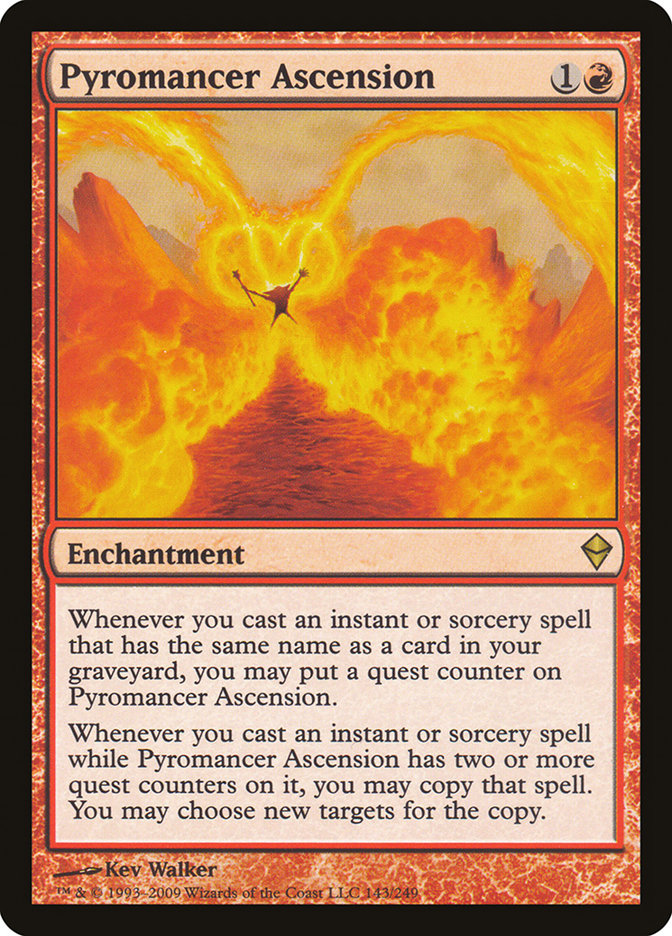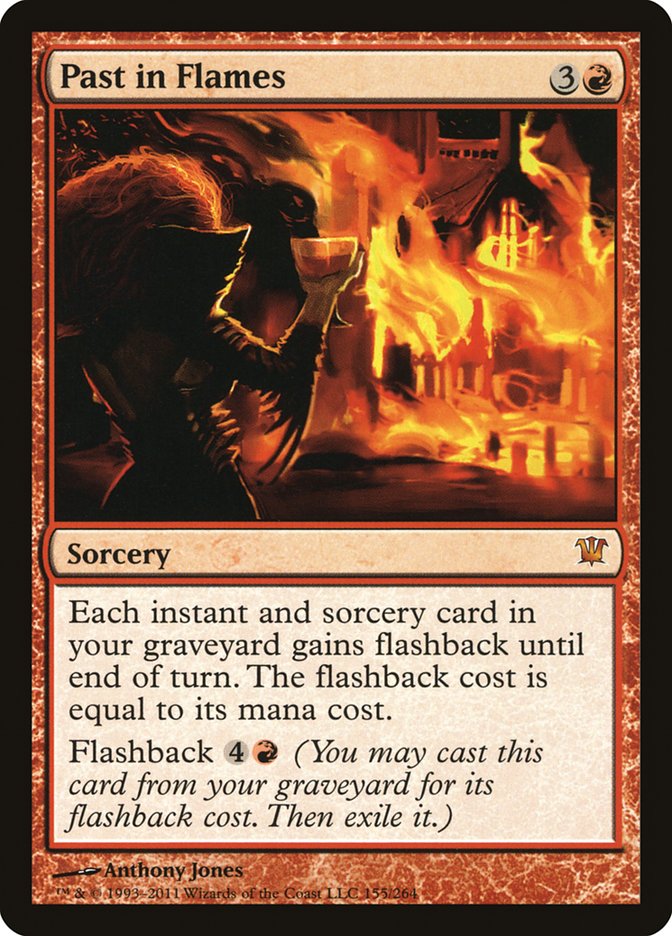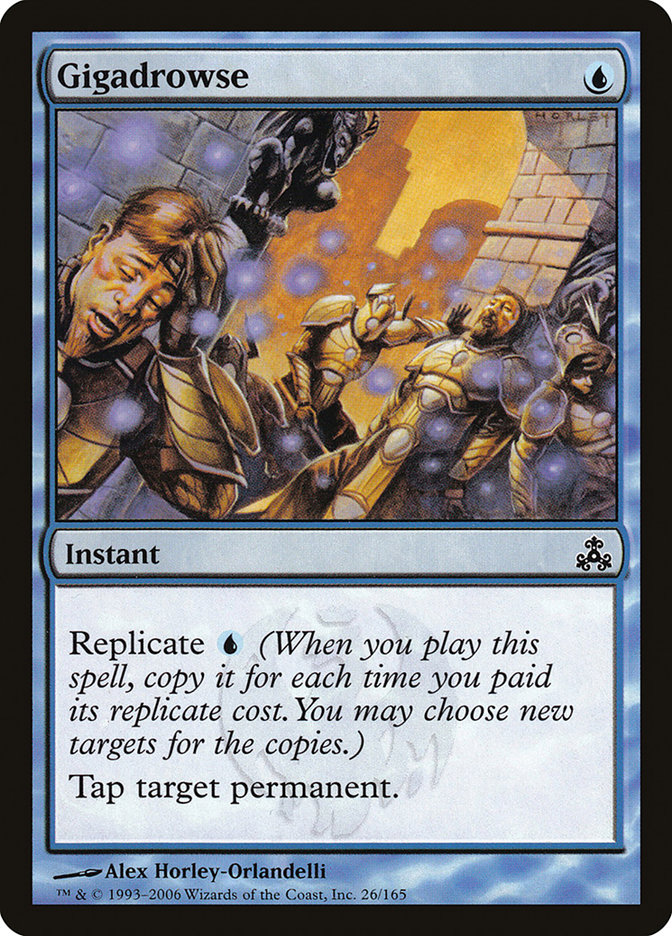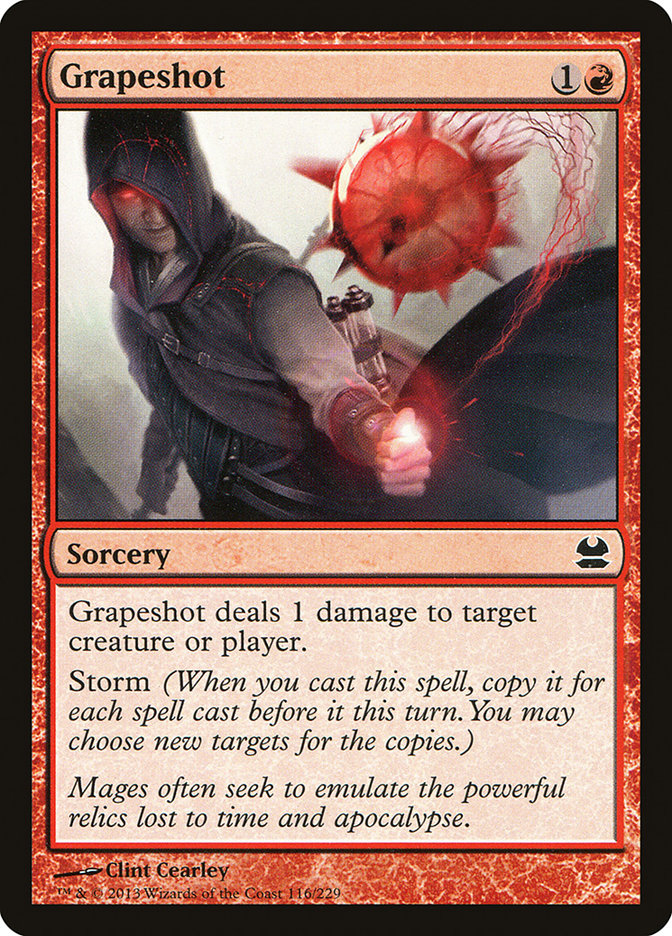I have a soft spot for critical mass combo decks. I can even identify the moment within my Magic history that forged this fondness within my heart.
I’ve quit Magic a handful of times, and it was usually drafting that brought me back each and every time. A friend or roommate or random acquaintance would invoke "The Rule of Six" and force me into a chair. The battle for Andrew Jackson would commence, and inevitably I’d start going to the shop every week once more in search of glory and free pizza. However, I would still occasionally go years without playing Constructed!
The deck that reeled me back into Constructed Magic for good? Pyromancer Ascension. Cliff Weixler, one of the few Floridian forces of good in this world, loaned me a Standard copy of the deck when I randomly showed up at a qualifier tournament to end my long hiatus from Constructed. Playing it was an eye-opening experience because I’d never played a deck that appealed to my sense of math and pattern recognition so thoroughly.
I made a zillion mistakes, of course, but as I learned the ins and outs of the deck, it became a fast favorite. I believe I made Top 8 of the tournament, and I was hooked. Attacking was for suckers, and I was a changed man.
Just think—he could’ve loaned me the Sudden Impact deck!
Ever since then I’ve respected these decks and explored them whenever I’ve had the opportunity. Some people might find them a bit dull—you are, after all, basically turning yourself into a human calculator—but identifying lines and discovering new patterns is actually very rewarding. The more obsessive-compulsive you are, the better it feels!
Of course, there’s something to be said for decks that just murder the opponent out of nowhere as well. Combo decks are often very powerful in the right metagame, so if your favorite math problem isn’t ripe for the current environment, fear not—it’s very likely to eventually improve and become a good choice.
Today’s Mathletes entry comes from "obv" on Magic Online. It’s a surprising sight—I wouldn’t play most of these cards in a bad Draft deck!
Lands (17)
Spells (43)
- 4 Twiddle
- 4 Sleight of Hand
- 4 Serum Visions
- 4 Fertile Ground
- 4 Gifts Ungiven
- 4 Dream's Grip
- 2 Overgrowth
- 3 Ideas Unbound
- 4 Utopia Sprawl
- 1 Grapeshot
- 2 Manamorphose
- 3 Past in Flames
- 4 Hidden Strings
Sideboard

Go ahead, hover over each of the card names and check what they do.
Sensing a theme?
This deck would give Evan Erwin arthritis inside of two matches!
At SCG Open Series: Seattle a few months ago, Gavin Verhey recounted a story in which a player told him he had a Hidden Strings deck. Gavin, having been around to see this card go from file to fifteenth pick—was eager to see the brew. To his disappointment, it was more of a deck with Hidden Strings in it.
Well, this one’s for you Gavin! We’re Stringing up a storm—quite literally!
The purpose of this variation on the "rituals into storm spell" motif is to create a land that taps for more than one mana, adding enchantments to it and using various Twiddle replicas to generate mana, building Dark Rituals galore. As you accumulate mana, you eventually reach the point at which you can cast a Past in Flames that should all but guarantee a lethal Grapeshot following the flashback of all your Twiddles and draw spells.
Don’t forget you can Gifts to bin the Grapeshot and then use Past in Flames to access it! As a matter of fact, you can Gifts for a lot of stuff and flash it back, including Past in Flames itself. I wouldn’t be surprised if the common turn 4 kill is turn 3 Gifts for three Twiddle variants and Past in Flames!
"But Glenn! Why is this deck any better than regular Storm?"
It might not be—in fact, it might never be! Normal Storm is a little more consistent and has a surer kill with more flexibility; that’s true. However, this deck does have a few things going for it that regular Storm can’t really boast, and they merit consideration.
1) You only need one blue mana floating after you cast Past in Flames.
This is surprisingly relevant, as the Storm archetype we’re all familiar with generally either needs two floating or an Electromancer in play and the Goblin rarely lives through a turn cycle. Wise Storm players will often hold the Electromancer for the turn that they’re going off, hoping a hapless opponent taps out and winds up vulnerable to the walking ritual . . . but if they keep Bolt up all the time, then your 2/2 is mostly blank. You’ll need to string together two rituals after casting him, requiring four mana total, which is a slightly taller order than we’re usually looking for.
2) Lightning Bolt is a blank.
I think we just covered this one. Storm can blank it, but in general the Electromancer’s upside is so high that it’s worth the risk. In this archetype, we’re completely creatureless. If the opponent is casting Lightning Bolts, they better kill us!
3) You are (probably) less vulnerable to Abrupt Decay.
While this deck runs more Abrupt Decay targets than conventional Storm decks, they are all fairly redundant, and thus it doesn’t matter as much to see one destroyed. Losing Pyromancer Ascension in response to its second counter or Goblin Electromancer on a key combo turn can be devastating—odds are good you can bounce back from losing Fertile Ground, as the deck runs effectively ten variants on the card and could run more if it wanted to.
Plus, at the end of the day, Abrupt Decay is still just a removal spell, and this deck has fewer cantrips and more card draw than Storm. That means getting one-for-oned is less scary!
Another note that by staggering your enchant lands, you have the ability to make the opponent choose between Abrupt Decay and Ooze activations on the critical turn—a dilemma you should be able to rig in your favor. Not many Modern decks or pilots will threaten multiple Ooze activations and Decay during the turns when this deck is trying to set up the kill. If they do, then that gives you a much longer clock and lets you draw more cards, making it more likely you go off anyway.
4) You are slightly better against attrition.
Because our pieces are more difficult to remove, it’s harder for the opponent to successfully attrition this deck—they have a few more blanks than usual. Also, we’re running Gifts Ungiven, the enemy of attrition decks everywhere! It can set up a combo or just help you recover against discard spells like Thoughtseize and Liliana of the Veil.
5) You have pseudo-weapons against graveyard hate.
Deathrite Shaman was a little annoying, but Scavenging Ooze has done a real number on Storm’s Modern viability over the past few months. This deck is probably about as vulnerable to those cards as regular Storm is—making it a wash technically—except that you will occasionally be able to Twiddle your way out against these cards. By entwining Dream’s Grip or aiming some of your other spells at opposing lands or Shamans, you can force the opponent to use their Ooze or Shaman at the least effective moment rather than trying to play straight through them.
The same goes for Nihil Spellbomb. However, Relic of Progenitus is still very tough to beat if the opponent leaves two lands untapped every time they pass the turn. That’s why we bring in Pithing Needle and Ancient Grudge, two tried and true answers to that particular problem. If G/R Tron is really popular, though, you may want to just avoid this deck completely.
Or you could try to jam a bunch of Stony Silence into the deck. That’s an option, albeit an ugly one.
Those might sounds like compelling arguments (#humble), but the truth is that each represents a marginal gain in a specific scenario. The key to evaluating a deck like this one is figuring out whether your metagame is positioned to make those margins matter. If so, it might be worth a shot.
Of course, there are downsides too. While Storm hate is on the decline due to its recession within the format, land destruction is at an all-time high—Fulminator Mage is only getting better and better right now, and Tectonic Edge is a constant threat. Let’s not even consider the horror that is Cryptic Command in response to a Twiddle—ouch!
This archetype has access to some basics that fight the more efficient land destruction, but it’s going to be tough to fend off blue opponents on four mana who have access to interaction. You’ll need to kill them before they make their fourth land drop or just dodge their cards completely. Not ideal, but doable. If the game goes long enough, it will become very difficult to even imagine a winnable combination of cards you can draw!
The blue matchup is just so difficult in the main that those sideboarded Gigadrowses will need to work overtime in games 2 and 3. Giving up your U/W/R matchup is actually not such a crazy idea, as that deck is on the decline with the surge in Junk decks packing loads of land destruction and weapons against them, but I think it won’t be difficult to piece together wins on the back of Gigadrowse either. Forcing them to spend four on overloading Counterflux is basically the same difference and the only out to Gigadrowse that most decks run.
You could get real crazy and sideboard some Thrun, the Last Trolls—the man plan is probably very good here, as the new legend rule leaves U/W/R all but dead to a resolved Troll. If U/W/R rises up once more, any deck with green mana would be wise to remember Thrun.
Looking back at the original decklist, there are adjustments to consider.
It’s very odd to see only two Manamorphoses considering that it basically shortens the deck for free and also lends itself to Gigadrowse out of the sideboard. There’s also the obvious synergy with Past in Flames of course. Maybe I’m overvaluing the cantrip—obviously Manamorphose is absurd when we have access to Goblin Electromancer, but that’s not the case in this deck. Still, the heavy blue mana requirements within a deck playing tons of green enchantments, some of which require a Forest, make it worth trying at four. You might even be able to trim a land since you’re adding two cantrips to the deck. Trimming two lands to add a Manamorphose and another Simic Growth Chamber might be the best way to keep your balance, though I don’t know what the final trim should be.
One Grapeshot is daring, but you really don’t want to take forced mulligans with this deck by drawing redundant copies. Will you lose the occasional game to Deathrite Shaman, Thoughtseize, and eat your Grapeshot? Certainly it’ll happen. You can avoid it by adding another Grapeshot, but that’s a pretty unlikely sequence to fall victim to in general. Keep in mind that unless the opponent knows the exact decklist, they’ll often target a different card with Thoughtseize anyway. It’s rarely correct to hit the "kill" cards against ritual decks, as a critical mass usually allows them grab anything they need to finish the job anyway—the kill is a blank until the game is over.
Plus, now that I’ve sown doubt in their minds via this article, they might think you’re running two . . . except that if you know they know you’re running two, you should run one . . . but then they might know that you might know that they might know! Gah!
One of SCG’s Organized Play employees, Aaron Stickney, has been lamenting the loss of his favorite Modern deck, Eggs, for months now. This deck immediately sprang to mind as an archetype that offers a lot of what Eggs enthusiasts might enjoy. If you like playing one-sided combos that are a little off the wall—or if you really, really enjoy saying "Twiddle that"—then this might just be the deck you’ve been waiting for!
Glenn Jones
@SecludedGlenn
My Twitch Stream





